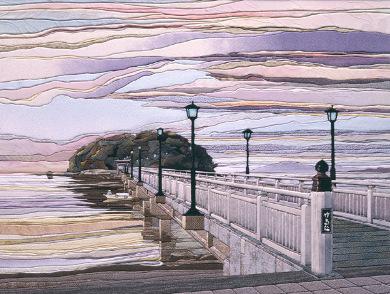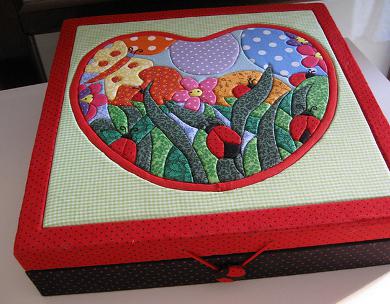Despite the fact that for many the word “patchwork” sounds unusual, it has been practiced for a very long time. It means
sewing from shreds. Patchwork is a unique kind of creativity. With it, you can create beautiful crafts that are needed on the farm and usefully get rid of old things that pile up in every house. Shreds are selected according to the color scheme and stitched into something whole. In the future, this turns into
blankets, bedspreads and much more. A patchwork without a needle does not require sewing. At first glance, its technology is simple. Take shreds, compose a drawing and create. However, not everything is as easy as it seems.
How Kinusaiga was born
If a simple patchwork was almost universal, then a needleless patchwork was invented in Japan. Maeno Takashi did this, and most recently, in 1987. The goal of the new work was the same as the usual patchwork sewing - to attach old things somewhere. The main clothes of Japanese women were traditionally kimonos. Beautiful, delicate to the touch, made of expensive silk. Of course, even worn them a pity to throw away. So they began to create masterpieces from them, at the sight of which breathtaking. They called such a patchwork without a needle kinusayga.
Despite the fact that this type of needlework originated in Japan, even there are few who deal with it. The reason for this is the great painstaking work. Pictures are made only by hand. Therefore, each, even the simplest in plot, becomes a work of art.
Classic Kinusaiga
A patchwork without a needle, the master class of which is given below, in fact, is not so difficult to perform. The process technology is as follows.
1. A board is taken.
2. The drawing is selected.
3. This pattern is applied on a board and on paper, preferably tracing paper, because it is transparent.
4. Each fragment is numbered. Check if the numbers on the paper and on the board match. They must match.
5. The paper is cut into drawn fragments.
6. On the plank, grooves are made in all lines. Their depth should be within 2 mm and a width of less than 1 mm.
7. Paper fragments with something, for example, pins, are fixed on the fabric of the desired colors and outlined with an allowance of a couple of millimeters along each contour.
8. Shreds are cut out and stacked according to their numbers on the plank.
9. Using any suitable tool, the edges of the patches are pushed into the grooves.
All. It remains to insert the picture into the appropriate frame.
The Difficulties of Japanese Patchwork

One involuntarily wonders if a patchwork without a needle is so simple, why are paintings in this style so expensive? Their cost starts from tens of dollars, and exclusive works cost several thousand. The fact is that a good picture, as a rule, contains a lot of tiny fragments. Sometimes their number is more than a hundred. All these patches are arranged not haphazardly, but as if the artist was painting a picture in oil. The tone of the patches is carefully selected to convey the magical beauty of dawn, the tenderness of the blossoming sakura flowers or the charm of autumn foliage fireworks. This is why a real kinusaiga is so difficult. A patchwork without a needle requires a lot of perseverance, care and talent. You can create an image yourself, or you can take a ready-made template. But in any case, you need to observe a combination of color schemes, precisely withstand the transition from light to shadow, perform a lot of small details so that the picture "comes to life".
Where to begin
If the soul has become attached to Japanese patchwork, but so far there is no experience, no confidence, no problem. The main thing is desire. Kinusaiga for beginners also exists. Its technology is the same as for experienced craftsmen. The only difference is the composition of the picture. It is advisable to start by choosing simple schemes in which there are few fragments and there is no great need to withstand tones and midtones. In this case, images of animals, such as a rooster or a parrot, are very suitable. Here you can pick up any shreds, and do not worry if somewhere they will not combine well. The main thing is to fill your hand.
You can also advise making a fly agaric. As they say, simple and tasteful. To facilitate the task, it is better to make the red part of the cap not holistic, but divide it into several fragments.
Also, for beginners, abstract paintings consisting of geometric shapes - squares, triangles, circles are suitable. If you select the colors successfully, it will turn out beautifully. Some people like this style even more than classical realism.
Board Replacers
The farther the kinsaiga conquers the world, the more new ideas appear in it. One of the last is a patchwork without a needle on polystyrene foam. Cutting even a simple drawing on a tree is quite difficult. Here you need special tools and skills in carving. Polyfoam is an ideal alternative. The only thing to remember is that it is fragile and breaks easily. Therefore, the finished product will have to be attached to the same board or to thick cardboard. In addition to polystyrene, expanded polystyrene is excellent, the texture of which is more durable. This kind of kaitinga is extremely convenient for beginners, because polystyrene and polystyrene are cheap, you can train on them as much as you like. Both materials are sold in any hardware store or on the market. Ceiling plates fit without volumetric patterns. At home they can be cut with ordinary scissors or a knife in the shape of a future painting. Further technology is the same as with a tablet.
Volumetric patchwork without a needle
The classic kinusig is very beautiful and is only admirable. But the inquisitive minds of the craftswomen come up with more and more of its variations. So, to give volume and realism to the images, they began to insert into the grooves not only the edges of the patches, but also pieces of lace. This improvement looks especially beautiful in paintings depicting ladies or children. The angle is chosen so that the face is not visible. The main emphasis is on creating fluffy
skirts, lace ruffles, ribbons and bows on hats and garters.
Those who use other materials, for example, gilded or simple threads, went even further. Also, some craftsmen attach beads, rhinestones or beads to a picture already assembled from shreds. More often, such elements are added to children's themes or to decorate New Year's toys, caskets, gift boxes.
Kinusaig style Christmas toys
You can create using Japanese technology any objects whose use does not imply mechanical deformations, for example, during the game. So, craftswomen use a patchwork without a needle for Christmas tree decorations, Easter eggs, Valentine's Day gifts and other cute little things. To make any of them, the same polystyrene is taken, only not the ceiling tiles, but pieces of thick plates. The blanks of the desired shape are cut from them. It can be balls, hearts, cones, any others. If there is no plate of the required thickness, the workpiece can be glued from fragments. Further work is carried out according to a general principle. Craftswomen for round balls are advised to take stretch, knitwear or velvet, because these fabrics fit better on the bulge. Some craftsmen stick patches on polystyrene to better hold. Such crafts look beautifully decorated with gold threads, “snow” from the same polystyrene or finely chopped rain.
Caskets and boxes

To craft a beautiful box or gift box, a needleless patchwork is also ideal. Schemes for these products are selected depending on the purpose of the product. If you intend to store jewelry in the casket, you can choose a picture with an elegant lady or some female accessory, for example, a hat. If the box will be used for children's little things, a drawing with a funny animal will do. But more often, images of flowers are taken for decoration. For simplicity of the task, it is better to take the most ordinary cardboard box of the appropriate size. From the foam cut rectangles corresponding to its sides. If only the lid is supposed to be decorated, the remaining sides are simply wrapped with a fabric in tone. Thin foam rubber can be pre-glued to cardboard. Further, on the central piece of polystyrene foam, the conceived kinusaiga is executed, attached to the lid of the box, and the casket is ready. To make it look beautiful around the edges, they are decorated with a ribbon or braid.
A few tips to conclude.
The kinusaig technique for beginners can seem complicated, especially if the edges of the rags do not want to stay in the grooves. Some try to glue them, but this results in worse results. It is better to try to make the grooves a little narrower and a little deeper.
When choosing an exposition of a future painting, it is advisable to avoid complex, too bizarre forms. Masters of Japanese patchwork often create landscape compositions or “draw” shreds of city blocks, houses and courtyards. Less commonly, flowers can be seen in the paintings. Even fewer people, especially faces. After all, it is almost impossible to make the face of the shreds look like a living one.
In order not to be mistaken and not to confuse the shreds, before you start pushing them into the grooves, you need to visually assess the future picture, because pieces of fabric are already laid out on the plank.